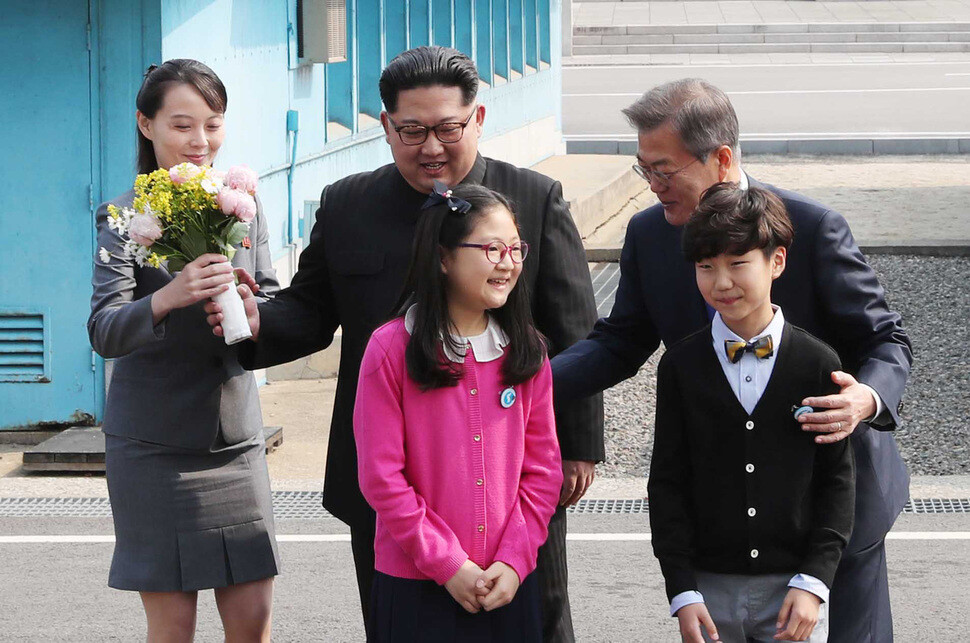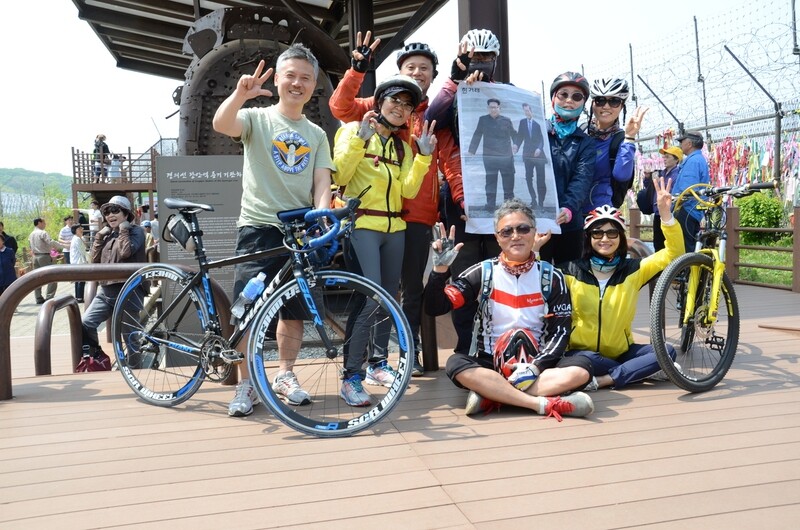hankyoreh
Links to other country sites 다른 나라 사이트 링크
Residents near North Korean border relieved at removal of propaganda loudspeakers

For South Koreans living near the border with North Korea in Paju, Gyeonggi Province, division has been part of their daily routine, from the barbed-wire fences running along the Imjin River to the roar of loudspeakers broadcasting propaganda back and forth across the border. For these people, the Panmunjeom Declaration that there would be no more war on the Korean Peninsula was bound to be of particular significance.
On May 1, four days after the inter-Korean summit, the removal of the propaganda loudspeakers marked the first concrete change in the daily lives of these people who thought their surroundings would never change. Children at the elementary school in the village of Daeseong-dong (also known as Freedom Village) in the Gunnae Township of Paju (the only school inside the demilitarized zone, or DMZ) no longer have to grimace when they hear the propaganda broadcasts.

This school, which is attended by the flower girl who handed a bouquet to South Korean President Moon Jae-in and North Korean leader Kim Jong-un before their summit, is just 1km from Panmunjeom and 400m from the military demarcation line.
“About two days before the summit, the constant propaganda broadcasts grew less frequent, and now I hear they’re going to remove the loudspeakers. I think the children and I should be able to relax when we have class outside now,” said a 42-year-old teacher at the school surnamed Lee.
On the afternoon of May 1, the South Korean government removed more than 40 loudspeakers as the first follow-up measure to the Panmunjeom Declaration.
Heo Sim, a 53-year-old resident of Paju’s Unjeong 2 neighborhood, gathered around 30 neighbors to hold an “ansim party” on the evening of Apr. 27. The little party started with a “dad joke” from Heo playing on the double meaning of the Korean word “ansim,” which can either mean “peace of mind” or “beef tenderloin.” Now that residents could live with peace of mind thanks to the summit, he decided the best thing to do was to hold a party and enjoy some tenderloin.
“To get the mood going, I bought 4 kilos of tenderloin and cooked it for everyone. Everyone enjoyed it, though I don’t know if that was the summit or the fact that they got to eat expensive beef,” he laughed.
Heo’s home in Paju is “close enough that we could have a catapult battle with the North if war breaks out,” he said. Mt. Songak in Kaesong, North Korea, is as clearly visible as Seoul’s Mt. Bukhan from Jayu Road, which he uses to go to work. For Heo, peace holds a particularly deep significance.
“Feels like unification might come any day now”Ko Hyeong-gwon, a 54-year-old resident of Paju’s Munbal neighborhood, went on two “Imjingak bike rides” with eight of his friends around the time of the summit. The first one before the summit was to hope for its success; the second on Apr. 29 was to commemorate a successful event.
“It’s 35km from my house to Imjingak, and it’s just 15km from there to Kaesong,” Ko said.
“Once this declaration opens up the barbed wire fence, I’d like to do a ride from my house to Kaesong,” he added.

Ko and his friends had to stop their bicycles at Imjingak after the summit, but took a commemorative photograph there holding a copy of the Hankyoreh with a front-page photo of the South and North Korean leaders crossing the Military Demarcation Line together. Such an image would have been imaginable to them last year, when the threat of war was running high.
The summit also held special relevance for 43-year-old Paju resident Choi Su-in, who gave birth to her first child on the day then-President Roh Moo-hyun crossed the border for the 2007 Inter-Korean Summit. At the time, it seemed like the border might open up any day – but the next opening only came after her baby had grown into a fifth-year elementary school student. “Summit baby” Kim Kang-min spoke with a maturity that belied his years.
“My mom told me that the South and North Korean leaders met on the day I was born. After I saw this summit, it feels like unification might come any day now,” he said.

By Im Jae-woo, staff reporter
Please direct comments or questions to [english@hani.co.kr]

Editorial・opinion
![[Column] Season 2 of special prosecutor probe may be coming to Korea soon [Column] Season 2 of special prosecutor probe may be coming to Korea soon](https://flexible.img.hani.co.kr/flexible/normal/500/300/imgdb/original/2024/0426/3317141030699447.jpg) [Column] Season 2 of special prosecutor probe may be coming to Korea soon
[Column] Season 2 of special prosecutor probe may be coming to Korea soon![[Column] Park Geun-hye déjà vu in Yoon Suk-yeol [Column] Park Geun-hye déjà vu in Yoon Suk-yeol](https://flexible.img.hani.co.kr/flexible/normal/500/300/imgdb/original/2024/0424/651713945113788.jpg) [Column] Park Geun-hye déjà vu in Yoon Suk-yeol
[Column] Park Geun-hye déjà vu in Yoon Suk-yeol- [Editorial] New weight of N. Korea’s nuclear threats makes dialogue all the more urgent
- [Guest essay] The real reason Korea’s new right wants to dub Rhee a founding father
- [Column] ‘Choson’: Is it time we start referring to N. Korea in its own terms?
- [Editorial] Japan’s rewriting of history with Korea has gone too far
- [Column] The president’s questionable capacity for dialogue
- [Column] Are chaebol firms just pizza pies for families to divvy up as they please?
- [Column] Has Korea, too, crossed the Rubicon on China?
- [Correspondent’s column] In Japan’s alliance with US, echoes of its past alliances with UK
Most viewed articles
- 1[Column] Season 2 of special prosecutor probe may be coming to Korea soon
- 2‘We must say no’: Seoul defense chief on Korean, USFK involvement in hypothetical Taiwan crisis
- 3Is N. Korea threatening to test nukes in response to possible new US-led sanctions body?
- 4Division commander ordered troops to enter raging flood waters before Marine died, survivor says
- 5Amnesty notes ‘erosion’ of freedom of expression in Korea in annual human rights report
- 6Is Japan about to snatch control of Line messenger from Korea’s Naver?
- 7No good, very bad game for Korea puts it out of Olympics for first time since 1988
- 8[Editorial] Korea’s surprise Q1 growth requires objective assessment, not blind fanfare
- 9N. Korean delegation’s trip to Iran shows how Pyongyang is leveraging ties with Moscow
- 10Korea’s 1.3% growth in Q1 signals ‘textbook’ return to growth, says government